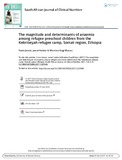The magnitude and determinants of anaemia among refugee preschool children from the Kebribeyah refugee camp, Somali region, Ethiopia

View/
Date
2017Author
Jemal, Yasin
Haidar, Jemal
Makau, Wambui K
Type
ArticleLanguage
enMetadata
Show full item recordAbstract
Background: Anaemia is a global public health problem affecting children from both industrialised and developing countries with major consequences for health, social and economic development. Although the burden of anaemia is high among refugee children due to their living conditions, its determinants are not yet clearly identified and documented in Ethiopia.
Objective: To assess the magnitude and contributing factors of anaemia among refugee preschool children of the Kebribeyah refugee camp.
Methodology: A cross-sectional study with an analytic component was conducted in the Kebribeyah refugee camp during March 2010. A total of 399 refugee children aged between 6 and 59 months were randomly selected and assessed for anaemia status using HemoCue® devices.
Results: The prevalence of anaemia was 52.4%. Most of the anaemic children, 36.6%, were classified as having moderate (Hb 7–9.9 gm/dL), followed by severe, 10.5%, (Hb < 7 gm/dL) while the remaining 5.3% had mild anaemia (Hb 10–10.9 gm/dL). The age of the child, paternal educational level, number of children younger than five years of age in the household, sharing/selling part of ration, inadequacy of ration stock, presence of diarrhoea, personal hygiene of the child, stunting and underweight were significantly associated with anaemia.
Conclusion: The purpose of this study was to demonstrate that anaemia is a severe public health problem among young refugee children and to document its major predisposing factors. In the Kebribeyah refugee camp, these included inadequate food rations, insufficient micronutrient composition, lack of provision of non-food items, selling and sharing of food rations, poor environmental sanitation, poor housing conditions, lack of nutrition/health education and disease (diarrhoea). A comprehensive nutrition service together with a holistic public health-focused approach to empower refugees to prevent the onset of anaemia by engaging in homestead small-scale food production for income generation and improving the integration and collaboration between beneficiaries, food donors and humanitarian aid organisations would be crucial in addressing the consequences of anaemia in the Kebribeyah refugee camp.
URI
http://medpharm.tandfonline.com/doi/abs/10.1080/16070658.2017.1237446http://hdl.handle.net/11295/100758
Citation
Jemal, Y., Haidar, J., & Kogi Makau, W. (2017). The magnitude and determinants of anaemia among refugee preschool children from the Kebribeyah refugee camp, Somali region, Ethiopia. South African Journal of Clinical Nutrition, 30(1), 1-6.Publisher
University of Nairobi
